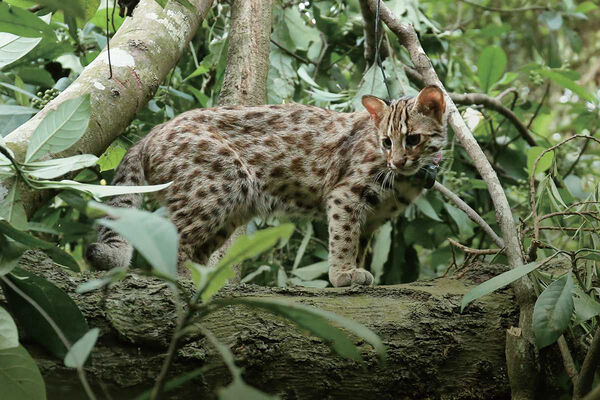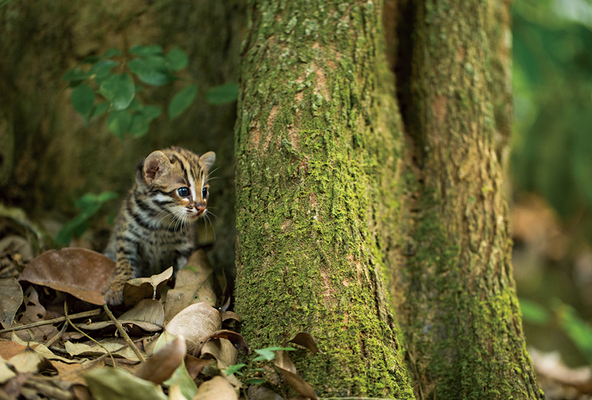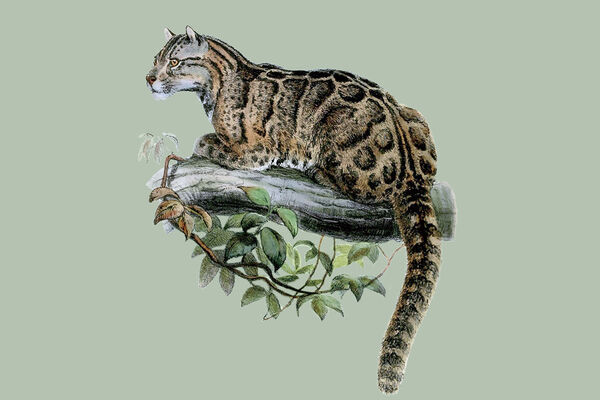leopard cat
IUCN
LCBasic Information
Scientific classification
- name:leopard cat
- Scientific Name:Prionailurus bengalensis,Civet cat, raccoon, copper coin cat, stone tiger, raccoon, mountain raccoon, wild cat, money cat
- Outline:Carnivora
- Family:Carnivora Felidae Prionailurus
Vital signs
- length:36-66cm
- Weight:1.5-5kg
- lifetime:4 years in the wild, up to 20 years in captivity
Feature
Wild cats covered in "copper coins"
Distribution and Habitat
Origin: Afghanistan, Bangladesh, Bhutan, Brunei, Cambodia, China, India, Indonesia (Java, Sumatra, Kalimantan), Ryukyu Islands, South Korea, North Korea, Laos, Malaysia, Myanmar, Nepal, Pakistan, Philippines, Russia, Singapore, Thailand and Vietnam.
Uncertain: China (Macao)
Widely distributed in my country (except for the arid areas in the north and west); from Afghanistan, through the Indian subcontinent, to Southeast Asia, Russia and North Korea.
Leopard cats mainly live in mountain forests, suburban shrubs and near forest edge villages. The distribution altitude can be distributed from the low-altitude coastal zone to the high mountain forest area at an altitude of 3,000 meters. Leopard cats' dens are mostly in tree holes, soil holes, under stones or in stone cracks. They are mainly terrestrial, but have strong climbing ability and can move freely and flexibly in trees. They are nocturnal and more active at dawn and dusk. They live alone or in pairs. They are good at s
Appearance
The body is similar to that of a domestic cat, but more slender and with longer legs. The southern species have a light brown or buff base color, while the northern species appear grayer with darker spots. The pattern is always unique and usually has four main stripes from head to shoulders, which are wide and distinct, but disappear at the spine. The sides of the body are spotted, but never in a continuous vertical stripe. A distinct white stripe runs from the nose to between the eyes and often to the top of the head. The ears are large and pointed, black behind the ears with white spots. Two distinct black stripes run from the inner corner of the eye to the base of the ear. There is a white stripe from the inner corner of the eye to the nose, and the muzzle is white. The tail is long (about 40-50% of the head and body length) and annular, ending in a black tip. In terms of the skull, the nasal bones are not everted; the upper jaw has a concave coracoid process, and the postorbital ri
Details
Ocelots are small, beautiful wild cats, named after their leopard-like patterns. Although they are similar in size to domestic cats, they have slimmer bodies and longer legs because they have lived in the wild for a long time.

Leopard cats are also called "money cats" in China because the spots on their bodies look like Chinese copper coins. Leopard cats have 12 different subspecies, of which 4 are distributed in my country. Although the fighting power of leopard cats is not as good as that of large animals, they are also very strong, and their survival skills are quite strong.
Leopard cats are the most widely distributed cats in my country, and also one of the most numerous cats. In the past, they were very common, but they were easily mistaken for wild cats. However, nowadays, leopard cats are only common in the southwest of my country, and they are rarely seen in other regions.
Leopard cats were once one of China's traditional foreign trade export furs. In the 1960s and 1970s, China purchased about 200,000 to 250,000 leopard cat furs annually, and it is estimated that the number of leopard cats in the country is no less than 1 million; after the 1970s, the number of leopard cats in most provinces and regions decreased, and in some provinces and regions (such as East China), leopard cats almost became endangered species; after the 1980s, the annual purchase volume was about 1/2-1/3 of that in the 1960s.
Leopard cat is listed in the "Red List of Threatened Species of the World Conservation Union" (IUCN 2014 ver 3.1) - Least Concern (LC).
Leopard cat Philippine subspecies is listed in the "Red List of Threatened Species of the World Conservation Union" (IUCN 2008 ver 3.1) - Vulnerable (VU).
Leopard cat Iriomote subspecies "Red List of Threatened Species of the World Conservation Union" (IUCN 2014 ver 3.1) - Critically Endangered (CR).
Leopard cats are listed in Appendix II of the Convention on International Trade in Endangered Species of Wild Fauna and Flora (CITES).
Leopard cat populations in Bangladesh, India and Thailand are also listed in Appendix I of the Convention on International Trade in Endangered Species of Wild Fauna and Flora (CITES).
Leopard cats are listed in the List of Terrestrial Wildlife with Important Economic and Scientific Research Values under State Protection issued by the State Forestry Administration of China on August 1, 2000.
Listed in the second level of the List of Key Nationally Protected Wildlife in China.
Protect wild animals and stop eating game.
Maintaining ecological balance is everyone's responsibility!
FAQ
What is the difference between an ocelot and an ordinary house cat?
An ocelot looks like a small leopard, with unique stripes or marble patterns. It is lively and energetic, and prefers to interact and play more than ordinary house cats.
Are ocelots suitable for domestic breeding?
Ocelots are very suitable for family breeding, but the owner needs to have enough patience and energy to provide sufficient companionship and interactive space.
Will ocelots destroy furniture?
Since ocelots are energetic, they may scratch furniture or climb. It is recommended to provide special toys or cat climbing frames for them to release energy.
Are leopard cats docile?
Leopard cats are generally friendly and affectionate, but each leopard cat has a different personality. Early socialization training can effectively improve their affinity.
How long do leopard cats live?
Leopard cats generally live about 12-16 years. A good diet, adequate exercise and regular medical care can help them live longer and healthier.












